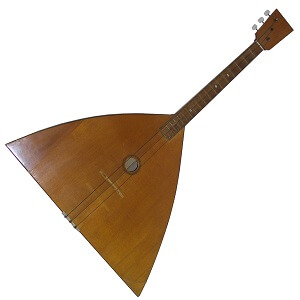Balalaika
 Balalaika, Russian stringed musical instrument of the lute family. It was developed in the 18th century from the dombra, or domra, a round-bodied long-necked three-stringed lute played in Russia and Central Asia. The balalaika is made in six sizes, from piccolo to double bass, and has a flat back and a triangular table, or belly, that tapers to the fretted neck. A small round sound hole is located in the narrow end of the belly. The three strings, usually gut, are end hitched and strung over a violin-like, or pressure, bridge. They are normally plucked with the fingers, although metal strings are also plucked with a leather plectrum.
Balalaika, Russian stringed musical instrument of the lute family. It was developed in the 18th century from the dombra, or domra, a round-bodied long-necked three-stringed lute played in Russia and Central Asia. The balalaika is made in six sizes, from piccolo to double bass, and has a flat back and a triangular table, or belly, that tapers to the fretted neck. A small round sound hole is located in the narrow end of the belly. The three strings, usually gut, are end hitched and strung over a violin-like, or pressure, bridge. They are normally plucked with the fingers, although metal strings are also plucked with a leather plectrum.
The instrument was used in folk music but was also employed in large balalaika orchestras formed in the 20th century. The representative size, called the prime, or treble, is usually tuned E–E–A in the octave above middle C.
Andreev first played in the orchestra, then conducted it. At the same time, he gave solo concerts, the so-called balalaika evenings. All this contributed to an extraordinary surge in the popularity of balalaika in Russia and even abroad. Moreover, Vasily Vasilyevich brought up a huge number of students who also tried to support the popularization of the balalaika (Troyanovsky and others). During this period, composers finally paid attention to the balalaika. For the first time the balalaika sounded with the orchestra.